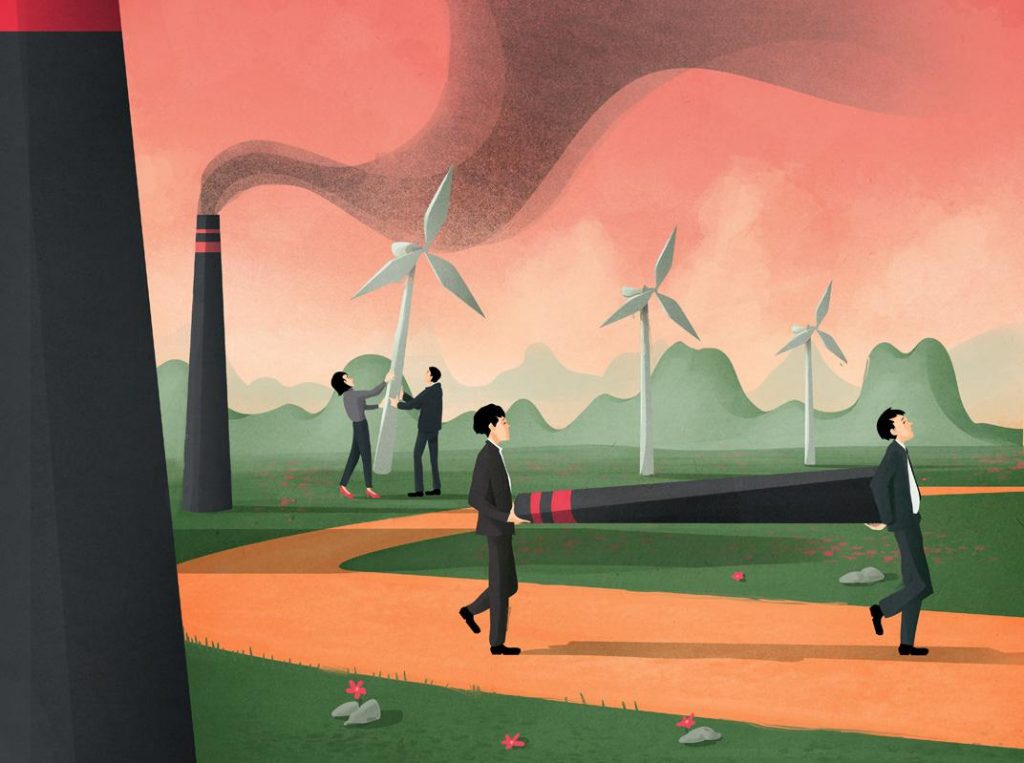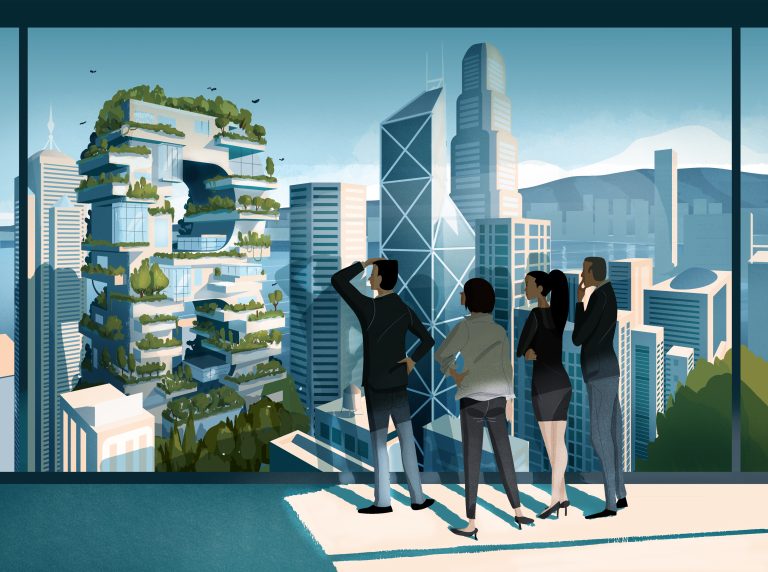Earlier this year, PwC Mainland China and Hong Kong announced that all staff would be eligible for first-class tickets when taking high-speed trains between Beijing and Shanghai, regardless of their grade. What may sound like a perk, was actually part of the firm’s strategy to reduce its carbon emissions. Beijing-Shanghai is the most frequent domestic travel route taken by its employees, and emissions from train travel are 96 percent lower than those from air travel.
“Climate change is one of the most pressing problems facing our world today. Limiting temperature rises to 1.5 degrees celsius above pre-industrial levels is our best chance of avoiding the most dangerous impacts of climate change,” says Cyrus Cheung CPA (practising), Partner, Environmental, Social and Governance (ESG) Services, PwC Hong Kong.
In its latest report, the Intergovernmental Panel on Climate Change warned that the world must nearly halve its CO2 emissions by 2030 and reach net-zero CO2 emissions by mid-century to limit temperature rises to this level.
The urgency of the need to respond to climate change has led a growing number of companies to introduce so-called net-zero targets – defined as reducing their CO2 emissions as much as possible and then offsetting what is left by removing an equivalent amount of carbon from the atmosphere through purchasing carbon credits.
On a mission
PwC has set the target of achieving net-zero greenhouse gas (GHG) emissions by 2030. It aims to reduce its scope 1 emissions, defined as direct emissions from owned and controlled sources, and scope 2 emissions, defined as indirect emissions from the generation of energy it purchases, by 50 percent by 2030 from a 2019 base through enhancing energy efficiency in its offices, and using only renewable energy.
Importantly, the net-zero commitment includes a target to halve emissions from business travel, included under scope 3 – indirect emissions that occur in a company’s value chain. It also commits to engaging its supply chain to reduce their emissions, also under scope 3 emissions, by setting the goal that 50 percent of its suppliers of purchased goods and services must have set their own carbon reduction goals by 2025. The firm will offset its remaining emissions through investing in high-quality carbon credits, such as carbon removal projects like reforestation or new technologies to directly remove carbon dioxide from the air.
Link REIT has set a net-zero target for 2035. Calvin Kwan, Head of Sustainability at Link REIT, explains that he thought it was important to set a timeframe that was close enough for him to be able to see the plan through, but still far enough away to allow time for improvements in technology to assist in achieving net-zero.
Link REIT is taking a four-pronged approach to achieving its target, namely reducing the amount of energy its buildings use, looking for technology it can harness to enable it to become more energy-efficient, installing renewable energy generation capacity, such as solar photovoltaic (PV) cells across its portfolio, and procuring renewable energy and carbon credits for its remaining emissions. “There will be a chunk of the carbon footprint that we can’t reduce, so from 2025, this will be covered through purchasing renewable energy credits and carbon offsets. There is a lot of debate about whether you should do that, so for every subsequent year to 2035, we will reduce our reliance on carbon credits,” Kwan says.
Real estate services group JLL has set a target to reach net-zero for scope 1 and scope 2 emissions by 2030, with scope 3 emissions reaching net-zero by 2040. Andrew Lau, Energy and Sustainability Lead at JLL in the Greater Bay Area and Taiwan, says the first step has been to review its property portfolio, close its worst performing sites in terms of carbon emissions and move staff to better performing buildings.
To reduce its emissions further, it has set up an Eco Champions group under its facilities management team to share ideas and set targets on improvements the company can make to reduce its carbon footprint. It is also investing in technologies to make its workplace more energy efficient, such as installing smart meters in its Hong Kong offices. “It will help to improve our energy consumption and saving energy as a result” Lau says.
Despite the obvious challenges it faces as a power firm, CLP Holdings announced a target at the end of September to reach net-zero GHG emissions across its entire value chain by 2050. It is also accelerating plans to phase out coal-fired generation assets by 2040 – a decade earlier than it has previously pledged.
The group sees the move to net-zero as an opportunity, as is diversifying its operations into areas such as renewable energy and technology solutions that will assist other businesses in becoming carbon neutral. “As we progressively phase out coal, our investment will be directed towards low-carbon streams of business including power transmission and distribution, renewable energy, new energy technologies as well as smart technology solutions that will help our customers become more energy-efficient and reduce their own carbon footprint,” Richard Lancaster, Chief Executive Officer of CLP Holdings Limited, says.
Dutch lighting company Signify, formerly known as Philips Lighting, achieved net-zero in September 2020, after first setting the goal in 2016. It has reduced its operational emissions by more than 70 percent since 2010, through a combination of using more energy-efficient technologies at its sites, more sustainable modes of transport, reducing business travel and optimizing logistics, including opting for sea freight rather than air freight, as well as only using renewable energy.
The balance of its emission reductions is achieved through a carbon offsetting programme with projects aimed at benefitting the well-being of local communities.
It is now working to go beyond carbon neutrality by doubling the positive impact it has on the environment and society.
“There will be a chunk of the carbon footprint that we can’t reduce, so from 2025, this will be covered through purchasing renewable energy credits and carbon offsets.”
Overcoming challenges
John Wang, President of North East Asia, Signify, says the biggest challenge the Signify faced in its journey was the fact that some emissions were unavoidable due to its economic activities. “Our solution was to compensate for CO2 emissions of our activities by preventing the same amount of emissions from entering the atmosphere elsewhere. We finance emission reduction projects that issue carbon credits. Each carbon credit is a certificate that corresponds to the reduction or avoidance of one metric ton of CO2 by that project,” he explains.
He adds that the group selects carbon offsetting projects that will have the maximum impact, while it also uses third-party verification, such as Verified Carbon Standard, Gold Standard or United Nations Clean Development Mechanism, to ensure the claimed emission reductions have actually been achieved.
Cheung says one of the critical things for PwC to get right in its journey towards net-zero was ensuring its targets were in line with climate science. As a result, it has had its targets validated by the Science Based Targets initiative, which defines and promotes best practice in emissions reductions, to model its emissions and set its reduction targets.
He adds that understanding PwC’s total emissions impact across the whole of its value chain and identifying its largest emissions sources was also challenging, as it required supplementing company data with environmental modelling techniques.
For Lau of JLL, the most challenging part of the process has been ensuring the integrity of the data it is using. “In a lot of countries, we don’t have the data we need, but we can’t manage what we can’t see,” he explains.
To overcome this challenge, JLL has introduced its own in-house carbon management platform, called Canopy. “Canopy can automatically capture data on electricity and water consumption, fleet travel and paper consumption and manage it across our global portfolio. It also forecasts what our consumption will be down the road and makes suggestions on how we can reduce it,” Lau says.
Kwan of Link REIT points out that another challenge is the current lack of standardization in carbon prices for purchasing carbon credits. He points out that in the EU carbon costs around 50 euros per ton, while in Mainland China it can cost as little as US$4 to US$5 per ton. He suggests there needs to be alignment between the different types of credit available and their cost. He also expects the cost of the credits to increase rapidly in the future as demand rises, creating financial burdens for organizations that have relied too heavily on offsetting their carbon, rather than reducing it.
Tapping into technology
Unsurprisingly, technology plays a significant role in helping companies to reach net-zero. JLL is using Internet-of-Things sensors in its offices, combined with artificial intelligence and big data analytics, to understand and reduce its energy usage. It has also installed lighting control sensors, which automatically dim lights in response to the amount of daylight there is, and occupancy sensors that turn off lights and computer monitors if nobody is in the office. “Achieving net-zero requires the deployment of existing low-carbon technologies at scale, and developing and adopting innovative new solutions and processes, many of which are at research and development (R&D) or other early stages of demonstration and commercialization,” says Cheung.
Among the technologies PwC is using is a digital Emissions Tracker, a data collection, storage, computing and analysis platform that provides insights into its emissions and how to reduce them. “We’re also building solutions to help our clients measure and report their sustainability performance. Our proprietary digital solutions include an ESG investment maturity diagnostic tool, ESG data and reporting tools, and a supply chain sustainability risk management platform,” says Cheung.
Link REIT is retrofitting its buildings to make them more energy efficient. Kwan explains that it is exploring having digital models created of its shopping centres and other properties to understand their carbon footprint and concentration, and model ways in which it can be reduced.
But while technology is important, he concedes that there is currently no “silver bullet” that enables companies to significantly reduce their emissions. “It requires each of us to have an open mind and look at things in a different way. When we do that, we can find a solution that pushes us towards net-zero,” he says.
Wang agrees that innovation was an important pillar of Signify’s strategy, saying the group invested 85 percent of its R&D budget in 2020 in sustainable innovation, such as developing more energy-efficient LED lighting. It also made investments in digital lighting solutions, cloud computing and circular economy designs to reduce its carbon footprint.
Ensuring long-term sustainability
Aside from the obvious environmental and social benefits, achieving net-zero has other advantages for companies. Cheung points out that cutting emissions also reduces operating costs over the long term through reduced energy usage, while it protects the business from the risks associated with climate change. “We know the costs [associated with climate change] are rising, and will continue to rise exponentially with every fraction of increased global warming. Managing climate and other environmental risks early, and embedding sustainability into business, is actually the only way to help sustain long-term viability,” he says.
Lau agrees: “I think our leadership make it very clear we can’t continue our business without achieving these targets because we want a sustainable business ourselves.”
Kwan adds that as many jurisdictions adopt carbon neutral strategies, such as Hong Kong’s target of reaching net-zero by 2050 and Mainland China’s of 2060, companies are likely to be forced to buy carbon credits or face carbon tariffs on the emissions they have not reduced.
He adds that investors are also becoming increasingly concerned about companies’ carbon emissions. “Investors will start weeding out companies that are under performing or that don’t have net-zero targets.”
He adds that over the coming years, net-zero businesses are also likely to be shown to be more resilient than those that have not set emissions reductions targets.
Kwan also thinks focusing on carbon reduction will help to drive innovation in companies and may unlock new business opportunities, such as Link REIT’s decision to install solar PVs.
Wang points out that it is also an opportunity for companies to create long-term value beyond just their financial performance. “Our world is increasingly feeling the pressures of population growth, resource scarcity and climate change. In response to these challenges, the United Nations launched the Sustainable Development Goals in 2015. We believe we play an important role in helping to achieve those goals,” he says.
“I think our leadership make it very clear we can’t continue our business without achieving these targets because we want a sustainable business ourselves.”
Getting started
The starting point for companies wanting to set a net-zero target is to understand exactly what their current emissions are, Cheung suggests.
Once this has been done, Lau says they can start developing a roadmap on how they will achieve reductions, including dates at which they want to reach certain milestones along the way. He adds that it is crucial that the plan is shared with employees to get them on board, while buy-in from senior management is also critical to its success.
Wang suggests companies should align their corporate priorities with their sustainability goals to enable them to engage better with their customers, employees and stakeholders. He adds that companies are unlikely to be able to do everything by themselves, and they should look to collaborate with others, both within their sector and across different industries.
Kwan stresses the importance of putting the right team in place. He explains that he deliberately chose people who were less experienced and were in their late 20s and 30s, as it was important to have people who could take ownership of the strategy and would still be there in 2035 to see the project through.
He adds that companies should also start as soon as possible. “Don’t worry about not having all of the answers right away. You just need to get started and keep plugging away at it.”
The role of accountants
Accountants have an important role to play in helping companies achieve net-zero. “As being carbon neutral is a substantial change for a company, accountants have an essential role to play in achieving the goal. Accountants are able to allocate budget, to embed carbon emissions reductions within the company’s decision-making processes and to track and report on the progress during the transition journey,” says Wang. He adds that accountants can also make sure that the net-zero goal is a core part of the companies’ business activities, in terms of budgeting, forecasts, and reporting on performance.
Kwan points out that in future, companies are likely to face the same stringent requirements to account for their carbon as they currently do for their finances.
Lau agrees: “When we talk about net-zero, we have to make sure that all the numbers we declare are accountable and can be audited.”
He adds that accountants can also play a role in helping top management understand the benefits of carbon reduction by demonstrating that it will lead to lower operating costs and a more efficient business.
Cheung expects there to be growing demand for ESG-related assurance services going forward. “There is a need for information to be consistent, accurate and reliable. The quality of the disclosed materials will be crucial,” he says, adding that accountants can provide assurance over climate and other non-financial related ESG data and disclosures.
He points out that the Big Four firms have also collaborated with the World Economic Forum to develop the Stakeholder Capitalism Metrics, a set of universal, material ESG frameworks and recommended disclosures that can be reflected in companies’ annual reports on a consistent basis.
The Hong Kong Institute of CPAs is also active in this area, and is represented on the Accounting for Sustainability’s Accounting Bodies Network, which is producing a series of guides looking at the practical steps finance teams can take to support organizations in their journey to achieving net-zero emissions. The Institute has also held a “Race to Zero” webinar series that will be available as e-seminars.
Net-zero targets are defined as reducing CO2 emissions as much as possible and then offsetting what is left by removing an equivalent amount of carbon from the atmosphere through purchasing carbon credits.

















